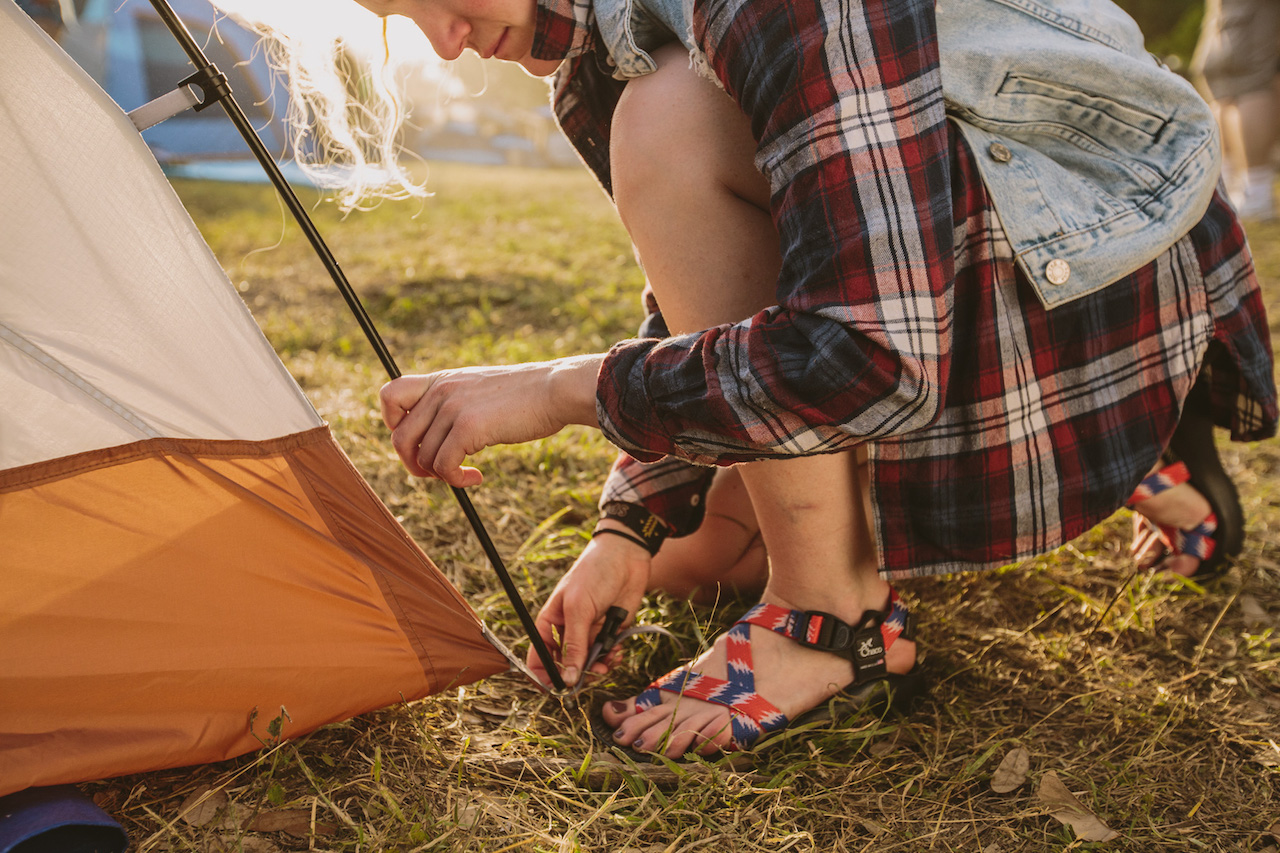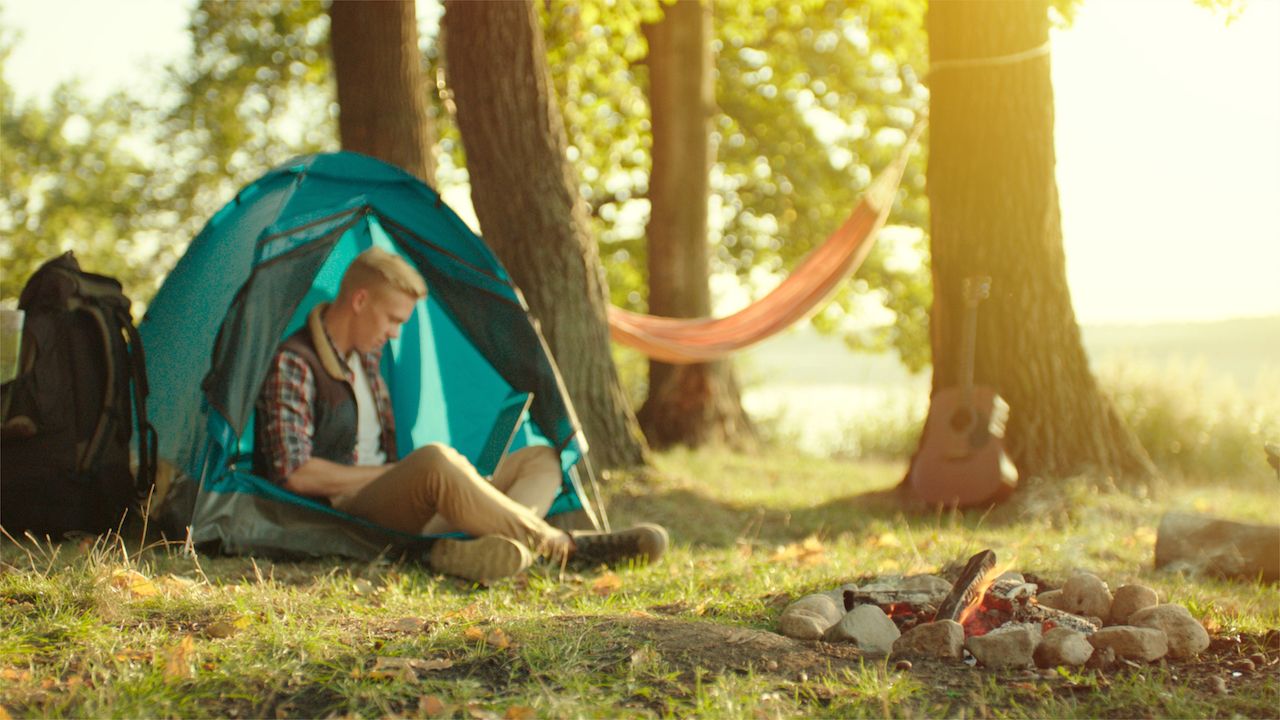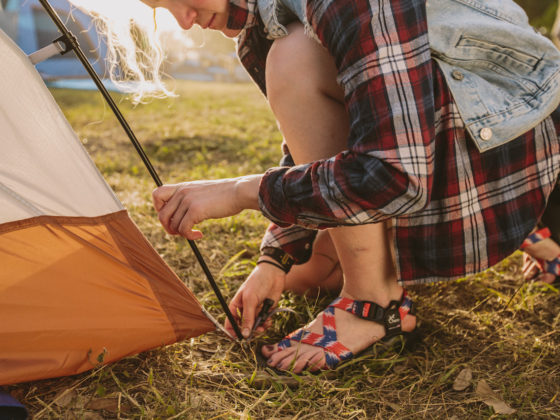“ESSENTIAL” MEANS MANY THINGS to many people. What’s essential to camping for me could well be frivolous to you. Acknowledging the basic absurdity of the “must-pack” list, I’m going to launch headlong into my own. I believe the mission of camping is to live briefly, simply, and joyously amid a wild and natural place — when camping alone, to experience a kind of pure and primal solitude; if camping with others, to enjoy the bond of the temporary nature adventure.
What you pack for a camping trip falls into two basic categories: needs and wants. Each of us camps slightly differently, so no two lists should be the same. However, I’d say this one is a good starting point — and a surefire way to have a damn good time.
NEEDS: SHELTER + SLEEP
This is basic Maslow’s Hierarchy of Needs stuff right here…
Backpack
You need a backpack. If you don’t have one, make this your first stop. A good hiking pack is the swiss-army knife of luggage. I have a Kelty Coyote and it has served me faithfully around the world since 2007 — including three trips to Burning Man (warning: some things never wash out).
Tent
Unless you’re sleeping in one of those hammock tent contraptions or you’re literally car camping, you’re going to need some kind of enclosure. Having a tent not only shields you from the elements, it satisfies the deeply held mammalian desire to curl up in a warm hole. My go-to is the REI Half Dome series.
Sleeping bag
When it comes to sleeping bags, it’s better to invest a little more and upgrade from those monstrosities you bought at Target and get something lightweight with goose down. My REI Flash sleeping bag is good for cold camping but is still comfy on a warm summer night. And when you’re packing up, the most important thing: It smooshes down real small.
Sleeping pad
For some people, a pad falls under “Wants,” but I’m 35 and I need that extra cushion between me and the jagged earth. I snooze peacefully on the REI Trekker series of sleeping pad.
NEEDS: CLOTHING

Images courtesy of Chaco Footwear. Photo credit: Carson Davis Brown. Styling: DXTRTY.
General
The first things to consider when packing clothes are climate, altitude, weather, and terrain. I always wear clothes I can layer on and off easily and that I don’t mind getting saturated in smoke and stained with burned marshmallows and the like. I almost always have the ubiquitous North Face shell with me — a kind of standard issue for campers of all stripes. It’s waterproof(ish), lightweight, and is good for a million scenarios. Oftentimes I wear light, water-resistant Prana climbing pants for the entire trip.
The best advice is to dress appropriate to the conditions and be ready for a temperature drop at night. If rain or fog is in the forecast, make sure you’re not wearing any cotton and you have waterproof gear.
Feet
Footwear, like everything else, is contingent on the terrain and climate you’ll be camping in. My go-to, all-purpose light footwear in warm climates are my Chaco Z/2 Classic sandals (which I want to be buried in). For gnarlier weather and terrain I have a well-worn pair of hiking boots.
If I’m wearing my boots, I’ll have my Chacos clipped onto my pack; after a day of hiking I might want to air out these stanky dogs. If it’s chilly, I wear light wool or synthetic socks and pack a second pair. I always bring some baby powder for my feet and shoes — it’s the little things, you know?
Head / face
Don’t forget to shade your face and eyeballs! Bring a beanie, ball cap, or bandana — whatever’s appropriate. And a pair of sunglasses, don’t forget those. If it’s going to be hot or you’re going to be in direct sunlight, you’ll be sorry if you’re not prepared. This also means bringing sunblock, of course.
NEEDS: H20 + LIGHT + FIRE + POO
H20
Fact: You have to drink water or you will die. This counts double while camping, so plan for it. If you’re car camping, bring a bunch of jugs or bottles; if you’re backpacking, use a CamelBak or Nalgene to transport water while hiking and source clean water or treat it by boiling, filtration, or iodine tablets. I use a 2-liter MSR hydration bag. When in doubt, bring more water.
Light
A headlamp is a beautiful thing. Get a good one and make sure it has fresh batteries. Bring an extra, too; someone will forget theirs.
A good knife
By “good” I mean a knife that can clean a trout, whittle a marshmallow stick, dice onions, and (possibly) fend off an angry Sasquatch. Personally, I think it’s basic Darwinian logic to carry a big blade when venturing into the wild, but maybe I’m old-fashioned.
Fire-starting material
If you’re allowed to have a fire, then you should. The experience of gathering and cooking around a fire is part of the magic of camping, so don’t forget to bring fire-starters — matches, newspaper, and kindling. If you’re limited on space and weight, dryer lint works exceptionally well as lightweight fire tinder. Make sure you pack for the Promethean gift of fire! And if you must, buy firewood at a grocery store.
TP
It’s always a good idea to have a roll on hand. Depending on the services — or lack thereof — at your campsite, you may need to supply your own. If you’re backwoods camping, you may also need to bring a small trowel to bury your poo (some wilderness areas require you to pack it out, so prepare for that, too). Nature is going to call — make sure you’re ready to answer!
NEEDS: FOOD

Photo: Jarno Holappa/Shutterstock
Cooler
Impractical if you’re hiking in, but indispensable if you’re car camping. Don’t forget ice. Or better yet, freeze bottles of water so when they thaw you aren’t drowning your snacks in meltwater (and, obviously, you can drink it). If you’re backpacking, you likely don’t want to pack in perishables that would require a cooler anyway. If you’re using a cooler, DON’T buy one of those disposable styrofoam coolers — they break apart and make the world a worse place. Instead, grab an Igloo cooler.
Food
When it comes to food, what you pack is dependent on a number of factors. Are you car camping? Backpacking? For how long? Do you have a stove? A fire pit? How many people are you feeding? It helps to sit down and make a list of meals and break them down into ingredients. It’s easy to over- or underestimate how much food you’ll need. If you’re hiking in, the easiest food option is often grabbing a selection of freeze-dried camp food — I’m a fan of Backpackers Pantry.
Mess kit
I love my Light My Fire mess kit: a bowl, a small cutting board that doubles as a strainer, a small cup, and a spork. Don’t pack unnecessary kitchen items and DON’T FORGET to bring a small squeeze bottle of dish soap — biodegradable camp soap if you’re in the wild. If you don’t have soap and you’re in a pinch, gravel from a riverbed can be used to scour out your dirty dishes.
Stove
Whether I’m car camping or backpacking, I use a tiny MSR stove that screws into the top of a fuel canister. This petite setup is perfect if you’re cooking one dish for one or two people, but if you’re prepping a bigger meal, you’ll probably need a larger stove. If so, get a griddle and multi-burner Coleman stove so you can throw down on some epic camp meals.
Utensils
Serving spoon, spatula, knife, can opener, bottle opener, wine opener, tongs, skewers. You know, the essential nonessentials.
WANTS: HANDY NONESSENTIALS
Tarp / blanket
Lay the tarp down under your tent for an extra layer between you and the earth, or use it as a rain shelter — it’s a lightweight and cheap solution to many camping conundrums. And an extra blanket for the beach, a cold night, or drying off around the fire is always welcome.
30 feet of rope
It doesn’t have to be thick or expensive, but you’ll always find a use for rope — from hoisting a bag of food out of reach of bears, to tying down your aforementioned tarp, to drying your clothes.
Bug spray
Don’t let a cloud of mosquitoes ruin your camping trip.
First aid
This is probably not a nonessential, but you’d be surprised how many campers don’t carry any first aids items. I recommend having a small-but-stocked first aid kit. Account for common camping scenarios such as bee stings, blisters, dehydration, and aches and pains. If you’re going deeper into the wild, be prepared for more serious injuries.
Waterproof dry bag
Most dry bags fold down to practically nothing, so stuffing one in your pack is easy. You won’t always need one, but when you have to keep essentials dry (in a raft, during a river crossing, during a downpour), a dry bag is your best friend.
WANTS: LITTLE LUXURIES & SIMPLE PLEASURES

Photo: Perevalov Alexey/Shutterstock
A good read / journal
Bring a book and sink into it for hours. Alternatively, write your own. Record your thoughts, write a haiku, sketch a still life, or just make a list of your mortal enemies.
A telescope or binoculars
You know, so you can see stuff that’s far away: sailboats, mountain goats, waterfalls, nebulae — stuff like that.
Music
I pack a harmonica or jaw harp. You can bring your uke or djembe. A little music goes a long way around a campfire.
A flask
A flask full of bourbon can make you a lot of friends — or just make the stars shine that much brighter.

